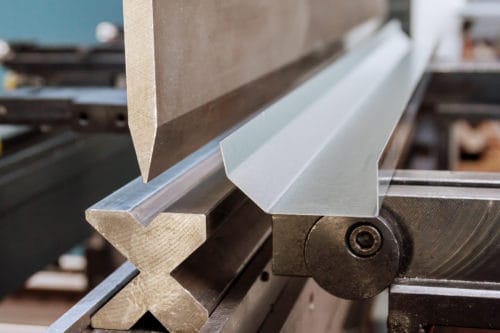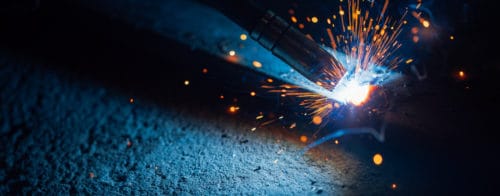What’s the Difference Between Welding and Metal Fabrication?
10 CommentsMany people refer to welding and metal fabrication as if they’re two different words for the same process. While both processes require working with metal, the terms are not interchangeable. Metal fabrication can be described as the process of creating a product out of metal. Welding is often a part of that process. There are a variety of processes in metal fabrication. Welding is only one of them. Yet welding is a specialized process that requires specific tools and knowledge not used during the other steps of metal fabrication. Learning how each process works can help you better understand the difference between metal fabrication and welding.

Welding and Metal Fabrication: What Are They Exactly?
Welding and metal fabrication are the processes used to shape, cut, bend, and join metal to make different products. Various tools and different methods are used throughout the process to achieve the desired result.
- Welding: A fabrication process where two pieces of metal are fused together by heat, pressure, or both is called welding. Welders use special tools to heat metal and form a bond to join two pieces or repair cracks. Typically, the bond forms completely as the metal cools.
- Fabrication: All processes that are used in building machines or structures from raw metals are considered metal fabrication. Processes may include cutting, burning, welding, machining, forming, and assembly. Sometimes, all processes of fabrication are completed in the same place, but some companies may outsource specific tasks, like welding, to other professionals.
Welding is a fabrication process, so it can technically be referred to as metal fabrication. However, there are many types of metal fabrication that don’t require welding. Therefore, a welder who only uses tools and processes used in welding cannot complete the entire metal fabrication process. Similarly, a metal fabrication shop without a welder cannot complete the welding part of fabrication without the right tools and skill set.
The Metal Fabrication Process
Metal fabrication is the entire manufacturing process used to create metal products or machines. Often, fabrication is completed by a group of specialists who complete different parts of a project. There are many steps in the metal fabrication process, which may include:
Bidding
Capable companies use a description of the product to create a bid for completion of the job. Bids may indicate the ability to complete the entire project in-house or include the cost of subcontracting some tasks to other professionals. One company will have a winning bid and begin the product.
Planning
Before any fabrication begins, the entire project must be carefully planned. Designers and engineers work with the client to understand the product uses and specifications. Then, a plan for the required tools and processes is organized by the team.
Production
The activities used to shape raw materials make up the production process. Production refers to all of the physical processes used to form the final product. These processes include:
- Cutting: Metal cutting is usually completed by machines. Waterjet and laser cutting are the most common technologies used for metal cutting today.
- Casting: Machine dies create molds for specific shapes. The fabricator pours molten metal into these dies to create metal parts.
- Forging: With the use of high-pressure machinery, raw metal is compressed so fabricators can bend and shape it.
- Punching: A punch press is used to punch pre-designed patterns into the metal for decorative or functional purposes.
- Drawing: This process places a specific amount of tension on liquid metal to pull it into a tapered die.
- Milling: A complex machine is used to shave the surface of metal, create angles, perforations, or holes into metal pieces.
- Turning: Metal is placed on a spinning platform to allow technicians to make radial cuts with a tool as the metal spins.
- Extrusion: Used to form cylindrical parts like pipes or wires, extrusion uses a ram to force billets through a die.
The Welding Process
 Welding is the part of the fabrication process used to join metal pieces together. Welders use a variety of specialized tools that comibine heat and pressure to fuse metal pieces together without compromising strength. Welding falls into two main categories:
Welding is the part of the fabrication process used to join metal pieces together. Welders use a variety of specialized tools that comibine heat and pressure to fuse metal pieces together without compromising strength. Welding falls into two main categories:
- Fusion Welding: The act of heating metal parts, then adding a filler to join them together, is called fusion welding.
- Solid-State Welding: A process that heats metal parts and joins them without using additives is referred to as solid-state welding.
Fusion welding and solid-state welding are used for different reasons. These are the four main welding processes used in metal fabrication:
- Shielded Metal Arc Welding (SMAW): A fusion method also known as stick welding, SMAW uses an electric current and welding rods to join metal surfaces.
- Oxy-Acetylene Welding (OA): A tank of oxygen and a tank of acetylene are used with a torch nozzle to create a flame that heats the metal while a filler rod is used for fusion.
- Tungsten Inert Gas Welding (TIG): TIG welding uses a non-consumable tungsten electrode to create the weld.
- Gas Metal Arc Welding (MIG): MIG welding feeds wire with a consumable rod fed through a continuous spool of electrode wire.
Metal fabrication requires a wide variety of processes to create many different products and machines. Welding is an important part of metal fabrication with its own distinct set of tools and processes. Contact the experts at T/J Fabricators to learn more about our metal fabrication processes, or request a quote to start your project today.




